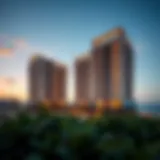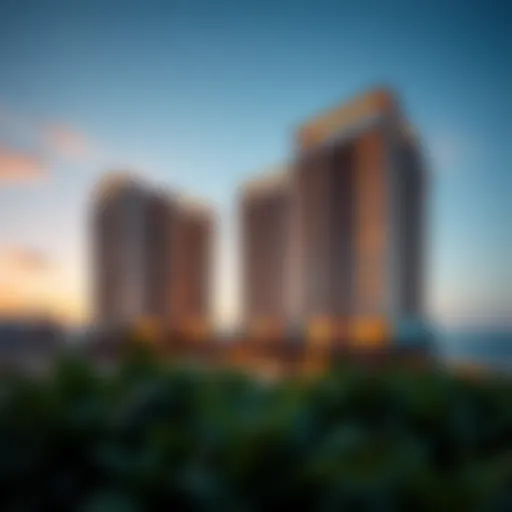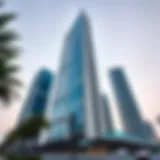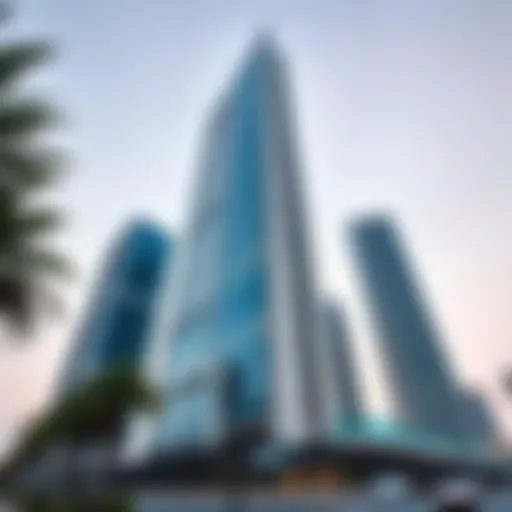Explore Khalifa Street: The Heart of Al Ain


Intro
Khalifa Street serves as the backbone of Al Ain, a city that beautifully blends modernity with tradition. This vibrant thoroughfare is not merely a road; it’s a lifeblood that pulses through the heart of the city. Offering a captivating mix of historical significance and urban dynamism, Khalifa Street is lined with shops, eateries, and significant landmarks that tell the rich story of Al Ain's growth and development.
As we embark on this exploration, we will not only delve into the street's history but also examine its evolving skyline, the surrounding neighborhoods, and the real estate prospects that arise from this prime location. Whether you are a resident or investor, understanding Khalifa Street's unique character is vital to grasping the broader economic and cultural landscape of Al Ain.
From the bustling commercial activities to the cultural sites that pepper the street, Khalifa Street reflects the essence of Al Ain’s community spirit. Thus, this comprehensive overview aims to provide readers with a detailed look, illuminating why this space is more than just a thoroughfare, but a significant avenue of life and commerce.
Now, let's turn our attentions to the contemporary market trends—one that can provide investors and locals a clearer picture of what lies ahead.
Market Trends
Current Real Estate Landscape
Over recent years, Khalifa Street has become a focal point for real estate activity in Al Ain. The area presents a mix of residential and commercial properties, making it attractive for both investors seeking rental income and families looking for a place to call home. The varied architecture reflects the city's historical roots, yet new developments are adding a modern flair that appeals to a younger demographic.
- Demand for Properties: The demand for properties along Khalifa Street is driven by its accessibility and the amenities available in the vicinity. The presence of schools, parks, and shopping centers enhances the appeal.
- Urban Development: Ongoing urban development projects are repositioning the area as a hub for business. As infrastructure improvements unfold, property values stand to benefit, showcasing an upward trajectory.
Property Price Trends
When assessing property prices, it's essential to consider both historical data and current market conditions. Over the past year, there has been a notable increase in property prices on Khalifa Street, with some prime units witnessing appreciation due to high demand.
According to various reports:
- Residential units are experiencing a yearly growth rate of approximately five to seven percent, particularly for properties close to popular landmarks like the Al Ain Oasis.
- Meanwhile, commercial properties are slightly higher, averaging around eight to ten percent.This reflects the ongoing commercial interest in the area.
"Khalifa Street stands as a testament to Al Ain's potential—a blend of tradition and modernity that is attracting a diverse group of stakeholders."
Understanding these trends is crucial for making informed investment decisions. Those looking to tap into this market should keep a close eye on the evolving landscape of Khalifa Street. The combination of historical significance and modern development offers a unique opportunity for both seasoned investors and new entrants.
As we move forward, it's imperative to touch on the investment opportunities that this street presents.
Prolusion to Khalifa Street
Khalifa Street serves as the lifeblood of Al Ain, not just a road but a vibrant artery running through the heart of the city. It's a place where past meets present, offering a unique glimpse into the everyday lives of the local residents while playing a crucial role in the city's development. This street is the embodiment of Al Ain's culture, commerce, and connectivity, making it a perfect case study for anyone looking to understand urban dynamics in the Emirati context.
Geographical Significance
Khalifa Street's geographical positioning is significant for several reasons. This thoroughfare connects various key parts of Al Ain, including residential areas, commercial districts, and recreational spots. Its strategic placement fosters easy access to multiple services, from shopping to education and healthcare. The street acts as a central hub that links different neighborhoods, facilitating movement and enhancing accessibility.
The orientation of Khalifa Street also accentuates Al Ain's landscape. Characterized by its blend of modernity against a backdrop of historical charm, the street and its surrounding areas reflect a nuanced understanding of urban planning in arid climates. For potential investors and homeowners, the appeal lies not only in the property values but also in the lifestyle benefits derived from living near such a vital thoroughfare.
Historical Background
Delving into the history of Khalifa Street reveals an evolving narrative that parallels the development of Al Ain itself. Once primarily a trade route, it has morphed over decades, transforming into the bustling street it is today. The early days encompassed local markets and small shops where residents gathered to exchange goods, fostering a sense of community that still thrives today.
As the city expanded, Khalifa Street adapted to new influences, integrating modern architecture alongside historically significant buildings. The evolving nature of this thoroughfare tells a story of resilience and adaptation, capturing the spirit of a city that honors its roots while embracing progress. Understanding this history is essential for anyone – from investors eyeing potential opportunities to researchers exploring urban development in the UAE.
"Khalifa Street is not just a passage; it is a vibrant segment of Al Ain’s story, echoing the changes and growth of the city through the years."
The neighborhood around Khalifa Street has flourished, influenced by both cultural shifts and economic changes. Each landmark along this road has a tale to tell, and as such, Khalifa Street stands as a testimony to the rich heritage and ambitions of a city that prides itself on being forward-thinking while remaining deeply rooted in tradition.
Cultural and Social Impact
Khalifa Street serves as more than just a channel for vehicles; it is the lifeblood of social interaction in Al Ain. The cultural dynamics along this street underscore the significance of community gatherings and events, fostering a vibrant atmosphere that attracts both locals and visitors alike. By discussing the cultural and social impact of Khalifa Street, we can understand how it shapes the behaviors, relationships, and communal fabric of the area.
Community Gatherings and Events
The essence of Khalifa Street pulses with life during community gatherings. Every weekend, families flock to various open spaces along the street. It’s a sight to behold – children running free, market stalls lined with colorful goods, and the enticing aroma from food trucks wafting through the air. These events not only bolster local commerce but also create spaces for cultural exchange.
During the cooler months, one of the most anticipated events is the Al Ain Culture and Heritage Festival. Locals set up art displays and traditional performance stages right on Khalifa Street. This festival exemplifies how cultural pride unites residents. It’s not just about the festivities; it’s about sharing traditions passed down through generations. Each dancer, storyteller, and artisan contributes to a rich tapestry of experiences that visitors can’t help but admire.
Additionally, community health markets have become regular features, focusing on wellness and healthy living. Various workshops are organized, encouraging discussions on nutrition and fitness. This reflects a strong community spirit and commitment to improving overall well-being. Moreover, these gatherings provide an opportunity for local businesses to connect with their audience, highlighting the interwoven nature of social and economic dimensions.
Festivals and Celebrations
Festivals hold a special charm along Khalifa Street. From Eid celebrations to national holidays, the street becomes a canvas for vibrant displays of cultural identity. During Eid Al Adha, for example, the street transforms into a festive boulevard adorned with lights and decorations. Families come together to enjoy parades, street performances, and local delicacies.
One cannot ignore the significance of Ramadan nights. As the sun sets, the streets fill with people coming to break their fasts together. This deeply rooted tradition fosters a sense of belonging and connection amongst various community members, where laughter and sharing are abundant. Food stalls offering traditional dishes spring up, turning the street into a banquet of sorts.
Furthermore, events like International Day of Happiness create an inclusive atmosphere. Local talents take center stage as musicians, poets, and performers showcase their skills. People from all walks of life gather, celebrate diversity, and share stories that form bonds beyond mere acquaintances.
"Khalifa Street is not just a road; it's a reflection of our culture, our memories, and our shared future."
Architectural Highlights
Khalifa Street in Al Ain is not just a central thoroughfare; it is a canvas displaying both modern design and historical craftsmanship. The architectural highlights of this street reflect the city's unique blend of heritage and progress, making it crucial for understanding Al Ain's identity. As we explore these structures, we uncover the dynamics at play in urban development and real estate along this significant route.


Modern Structures
With Al Ain experiencing rapid growth, modern architectures along Khalifa Street showcase innovative building techniques and materials. The skyline is punctuated by sleek office towers, luxurious residential complexes, and state-of-the-art commercial spaces. The Al Ain Mall, for instance, stands as a testament to contemporary design, merging shopping convenience with aesthetic appeal. The use of glass facades and environmentally friendly resources underline a commitment to sustainability.
Beyond just their visual impact, these modern structures play a vital role in the local economy. They attract business and tourism, fuelling further investment. Interestingly, many buildings are equipped with smart technology, promoting energy efficiency and enhancing the experience of both occupants and visitors. The push for modernity is clear, but it’s essential to ensure that this growth is balanced with the city’s cultural heritage.
Historical Buildings
In juxtaposition to the shiny new edifices, Khalifa Street is home to historical buildings that echo the past. Structures such as the Al Ain Oasis not only provide a glimpse into the traditional architecture but also serve a fundamental purpose in preserving local culture. The use of mud bricks and date palm fronds in construction illustrates a bygone era, where sustainability was inherently practiced.
A notable highlight is the Palace Museum, set amidst fertile gardens, showcasing the royal legacy of the region. This building upholds traditional Emirati design elements, like large courtyards and intricate wooden details, which invite both admiration and reflection.
"Understanding the architectural landscape of Khalifa Street is pivotal for investors looking to tap into Al Ain's vibrant property market. A blend of modernity and tradition creates unique opportunities."
Both modern and historical architectures serve as essential markers of Al Ain's evolving narrative. Investors should pay particular attention to how these elements influence property values and attract varying types of residents and consumers. The careful integration of modernity with historical significance not only enhances the aesthetic appeal but enriches the urban experience, making Khalifa Street an area of immense potential.
Economic Influence
Khalifa Street stands as a pivotal artery in Al Ain's urban landscape—its economic significance extends beyond mere commerce. This thoroughfare is more than just a road; it’s a bustling hub representing the heartbeat of the local economy. Investors, analysts, and homeowners alike should cast a keen eye on the developments occurring along this street. Understanding the economic influence in this area is crucial for making informed decisions.
Business Development
The business environment on Khalifa Street has been robust, showing signs of growth year after year. Local entrepreneurs and larger corporations are taking full advantage of the foot traffic that this central location brings.
- Diverse Industries: Retail shops, cafes, and professional services abound. Businesses ranging from trendy boutiques to essential service providers create a tapestry of options for shoppers and residents.
- Start-up Ecosystem: The street has become a breeding ground for start-ups, driven by the mix of old-school charm and modern amenities. Local incubators are nurturing budding talent, offering resources for companies just getting off the ground. Business owners here benefit from proximity to support networks and a customer base eager to explore new offerings.
- Strategic Location: Being centrally located, Khalifa Street appeals to businesses that want to attract both locals and tourists. This strategic significance increases the desirability of commercial spaces, often resulting in higher rental yields.
This flourishing environment not only enhances the economic landscape but also encourages investment from entities looking to capitalize on the increasing demand for commercial property in the region.
Retail Opportunities
Retail is a cornerstone of Khalifa Street’s economy, with a plethora of opportunities for both established brands and new entrants.
- Consumer Behavior Trends: The demographic mix on Khalifa Street is diverse, ranging from long-time residents to expatriates and tourists. This variety translates into a wide range of consumer preferences, making it essential for retailers to adapt to meet these needs.
- Expanding Market: The growth in population and the overall economic development in Al Ain have paved the way for increased retail opportunities. Areas like Al Ain Mall, which is a stone's throw from Khalifa Street, drive footfall and provide complementary shopping opportunities.
- Showcasing Local Culture: Many stores pride themselves on featuring local products. This focus on authenticity resonates well with consumers, fostering a sense of community while drawing in visitors wanting a taste of local culture.
As Khalifa Street continues to evolve, the potential for retail expansion remains high, creating a promising climate for investors looking to tap into this vibrant market.
Real Estate Dynamics
Understanding the real estate dynamics on Khalifa Street in Al Ain is crucial for anyone interested in the local market—be it investors, homebuyers, or real estate agents. This area has seen a notable transformation, aligning with Al Ain's broader urban development strategy. The vibrancy of Khalifa Street reflects not just its physical attributes but also its potential in real estate investment, making it a focal point for economic activity.
Key features of the real estate landscape here include an increasing demand for residential and commercial properties, which can be attributed to the street's strategic location. Residents and businesses benefit from easy access to various amenities, whether it's shopping, education, or cultural activities. Moreover, the placement of significant landmarks along the street enhances its attractiveness for living and commerce.
Property Prices and Trends
Over recent years, property prices along Khalifa Street have exhibited varied trends influenced by several economic factors. In particular, market fluctuations have been observed in response to changes in demand and supply, as well as broader economic policies tied to the UAE's growth initiatives.
Earlier this year, some apartment prices were reported to be on the rise, reflecting increased interest from both local and expatriate populations. The rental yields have also remained fairly robust, which is favorable for investors looking to capitalize on rental income.
Key considerations for buyers include:
- Location Advantages: Properties located near amenities such as schools, hospitals, and shopping centers tend to hold higher value.
- Market Data: It's essential to keep an eye on latest reports and trends from reliable sources such as Zillow or local agencies for current pricing.
- Regulatory Framework: Investors should familiarize themselves with local regulations that govern property purchases and ownership, specifically tailored for expatriates.
Investment Opportunities
The investment prospects along Khalifa Street are particularly appealing for those looking to diversify their portfolio. With the ongoing urbanization of Al Ain, the demand for both residential and commercial spaces is only expected to grow. This creates an excellent opportunity for investors aiming to benefit from capital appreciation and stable rental income.
Some promising avenues for investment include:
- Mixed-Use Developments: Properties that combine residential, retail, and office space can be exceptionally profitable given the multifunctional nature of the site.
- Luxury Residences: The rise in affluent residents searching for upscale living spaces points toward a lucrative segment.
- Commercial Rentals: As businesses seek optimal locations, investing in commercial properties or retail spaces becomes increasingly attractive.
"Investing in Khalifa Street provides not only immediate returns through rental income but also long-term capital appreciation, thanks to ongoing structural developments."
To navigate this promising landscape, connecting with local real estate agents who understand the intricacies of the market can be invaluable. Potential investors should also investigate platforms such as Property Finder to stay updated on available properties.
By recognizing the unique dynamics shaping the real estate environment on Khalifa Street, stakeholders can position themselves to make informed decisions that align with both their financial goals and lifestyle aspirations.
Transportation Infrastructure
Transportation infrastructure is a linchpin in the urban framework of Khalifa Street, influencing both daily commutes and overall city dynamics. The way residents and visitors move around plays a crucial role in shaping the vibrancy and accessibility of any urban area. This section focuses on two key components of Khalifa Street's transportation landscape: public transport accessibility and road connectivity.
Public Transport Accessibility
The access to public transport on Khalifa Street is nothing short of essential for the community. With a range of bus services connecting various parts of Al Ain, it enables seamless movement, particularly for those who may not have personal vehicles. Buses frequently circulate, reducing wait times and enhancing convenience.
- Major bus stops along Khalifa Street serve not just the local populace but also tourists visiting the area.
- Regular schedules and routes cater to peak hours, ensuring that the flow of commuters is smooth.
- Accessibility for people with disabilities has also seen improvements, with designated stops and facilities that cater to their needs, although there is still room for improvement in some areas.
Public transport accessibility stands as a pillar for community interaction, allowing diverse groups of people to come together, trade, and experience the cultural attributes that Khalifa Street offers. This function nurtures local businesses, instilling a sense of connectedness.
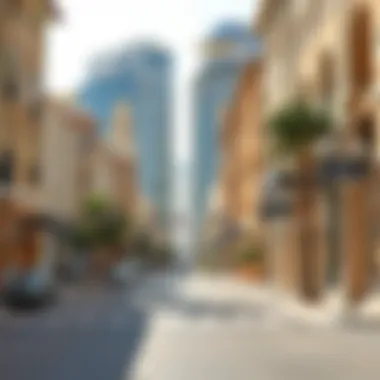

Road Connectivity
Khalifa Street boasts impressive road connectivity that serves as a gateway to a wider network of main roads and highways leading to and from Al Ain. This connectivity not only facilitates daily commuting but also enhances commercial and economic activities. Here are some key benefits associated with this connectivity:
- Proximity to Major Highways: Khalifa Street is strategically located near key highways like Sheikh Khalifa Road, which connects to other emirates easily.
- Reduced Congestion: Well-planned road systems help distribute traffic evenly, minimizing congestion during peak hours.
- Impact on Real Estate Prices: Homes and businesses located near well-connected roads typically see an increase in demand, affecting property values positively.
- Safety Measures: Ongoing development has led to the improvement of road safety features, including well-marked pedestrian crossings and lighting, which is vital for safety.
Strong road connectivity boosts the economic viability of Khalifa Street, facilitating trade and promoting growth.
Tourist Attractions
The presence of tourist attractions along Khalifa Street plays a pivotal role in shaping the identity of Al Ain. Not only do these sites draw visitors from near and far, but they also foster a sense of pride among locals. These attractions serve as a bridge between history and modernity, offering glimpses into the cultural richness and heritage of the city. Moreover, they contribute significantly to the local economy by promoting hospitality and related services, making them essential for stakeholders such as investors and community members alike.
Prominent Landmarks
Some of the most distinguished landmarks along Khalifa Street provide a visual feast and a historical narrative. For instance:
- Al Ain Palace Museum: This former royal residence showcases the opulence of the past while educating visitors about the emirate's history and heritage.
- Sheikh Zayed Bridge: A stunning architectural feat, it connects various parts of the city and is admired for its aesthetic appeal.
- Al Ain Oasis: A UNESCO World Heritage site, offering lush greenery amidst the desert, it acts as a sanctuary for both wildlife and city dwellers.
These landmarks not only hold architectural marvels but also offer recreational opportunities. They encourage leisurely strolls while imparting history and culture to residents and tourists. The blending of leisure and education is remarkably visible here, making it a hotspot for those seeking to immerse themselves in the local atmosphere.
Cultural Institutions
Cultural institutions scattered along Khalifa Street extend beyond mere tourism; they enrich the community. These institutions, such as art galleries, performance spaces, and museums, are cornerstones in promoting artistic expressions and cultural dialogues.
- The Cultural Foundation: This venue hosts exhibitions and workshops, acting as a conduit for local artists and international talent alike. It is a melting pot of creativity and knowledge dissemination.
- Al Ain National Museum: It houses artifacts that trace back to the earliest human settlers in the region, highlighting the historical significance of Al Ain.
- Art Hub: A delightful space for art aficionados, it provides programs and community events that connect people through creativity.
These institutions play a crucial role in preserving and celebrating the cultural heritage of Al Ain whilst being instrumental in fostering community engagement.
"The real beauty of Khalifa Street lies in its ability to serve as both a vibrant marketplace of ideas and a showcase for the rich tapestry of Al Ain's history and culture."
Residential Options
Residential options along Khalifa Street play a crucial role in shaping the livability and dynamism of this area. For investors, homeowners, and even renters, understanding the housing landscape is paramount. This section will shine a light on various types of housing available, as well as paint a picture of the communities that call this street home.
Types of Housing
When it comes to the types of housing that line Khalifa Street, variety is the name of the game. The options span from sprawling villas to compact apartments, catering to a wide spectrum of lifestyles and budgets.
- Villas offer generous spaces, often equipped with modern amenities, gardens, and private pools. Families seeking a homey environment typically gravitate toward these.
- Townhouses present a middle ground, combining the privacy of a standalone home with community features. They're snug and often come with shared facilities, making them popular among young professionals and smaller families.
- Apartments are a prevalent choice for many, particularly for those who value proximity to the commercial hubs and cultural spots of Al Ain. From studios to multi-bedroom units, the ranges are diverse and adaptable to varying needs.
- Luxury Residences provide an upscale living experience, often infused with high-end finishes and extraordinary views. These residences may appeal to expatriates and affluent locals alike who are willing to invest in a high standard of living.
Investors should also note that the real estate dynamics here are shaped by ongoing developments and urban planning, making it a noteworthy area for future property investment.
Community Profiles
The community surrounding Khalifa Street reflects a vibrant tapestry of cultures and backgrounds. The street serves not just as a thoroughfare but also as a communal space where interactions happen and relationships develop.
- Families: Many households here comprise young families looking for a supportive neighborhood. They are often drawn to the educational facilities nearby, which adds to the community’s appeal.
- Expatriates: Al Ain, being a melting pot of various cultures, has a significant number of expatriates residing in the area. This demographic adds to the multicultural fabric and encourages community events that celebrate diverse heritages.
- Professionals: A sizeable number of working professionals reside along this route due to its strategic location near business districts. Their presence adds a bustling energy to the street, driving demand for cafés and coworking spaces.
- Retirees: With the serene settings available, it has also attracted retirees looking for a relaxed lifestyle amidst modern conveniences. They tend to favor quieter residential options that foster community engagements.
In essence, the housing choices and resident demographics greatly influence the lifestyle and overall atmosphere of Khalifa Street, making it a pivotal area for real estate prospects and the local community.
Altogether, the diverse residential options not only address varying housing needs but also cultivate a rich and engaging community. From quaint residential pockets to lively hubs, Khalifa Street offers a unique living experience molded by its residents.
Environmental Considerations
As Al Ain continues to evolve, the significance of environmental considerations along Khalifa Street cannot be overstated. This stretch of urban space not only serves as a thoroughfare but also as a vital reflection of how urban areas can harmonize with their natural environments. In light of climate change, increasing urbanization, and a rising populace, the integration of thoughtful environmental strategies is more crucial than ever.
Green Spaces and Parks
Khalifa Street is embellished with a variety of green spaces and parks that punctuate the concrete landscape. These areas are not simply patches of greenery; they serve multiple purposes that benefit both the residents and the city as a whole.
- Recreational Areas: Parks along Khalifa Street offer residents convenient spots for leisure activities, from casual strolls to organized sports. Take, for example, the Al Ain Oasis, a short distance from the main thoroughfare. Its shaded pathways and thriving date palms create an ideal environment for picnicking families and fitness enthusiasts alike.
- Biodiversity: These parks support local flora and fauna, fostering biodiversity in an urban setting. The careful selection of native plants helps preserve the ecosystem, providing habitats for various species, thus enriching the urban ecology.
- Air Quality Improvement: Urban greenery assists in filtering pollutants, thereby improving air quality. The plants capture carbon dioxide and release oxygen, acting as natural air purifiers.
The potential of these spaces to enrich community life and promote health cannot be ignored. Investing in green infrastructure has a cascading effect on community well-being, enhancing overall quality of life.
Sustainability Initiatives
Alongside the development of parks, several sustainability initiatives are underway on Khalifa Street, reflecting a commitment to the environment that resonates with modern urban needs.
- Water Conservation: Various projects aim to implement smart irrigation systems that reduce water wastage in parks and green areas. Furthermore, rainwater harvesting systems are being explored to recharge the area's water supply sustainably.
- Renewable Energy Usage: Initiatives to harness solar energy for street lighting are being put in place, significantly cutting energy costs and reliance on non-renewable resources. This move towards solar power exemplifies a practical approach to sustainable urban living.
- Waste Management: Increased emphasis is being placed on efficient waste management, with recycling bins and educational campaigns encouraging residents to minimize waste. Programs such as these have the potential to empower the community to take actionable steps towards a sustainable lifestyle.
Green spaces and sustainability initiatives on Khalifa Street underscore the interconnectedness of urban development and environmental stewardship. With an eye towards future growth, these themes will play a pivotal role in shaping not only the physical landscape but the ethos of the community as a whole.
"Embracing sustainable practices today will safeguard the environment for future generations, ensuring Khalifa Street remains a vibrant part of Al Ain's rich tapestry."
In summary, the environmental considerations surrounding Khalifa Street encompass a wide array of strategies aimed at creating a livable, sustainable urban environment. As forward-thinking investors, homeowners, and city planners contemplate these aspects, they contribute significantly to the ongoing narrative of Khalifa Street as a cornerstone of Al Ain's transformation.
Future Developments


In the context of urban growth and change, future developments on Khalifa Street represent a crucial element of Al Ain’s urban fabric. The potential transformation of this area holds significance not just for immediate stakeholders but also for the city as a whole. Emphasizing the importance of future developments encompasses various factors, including economic vibrancy, improved infrastructure, and enhanced community amenities.
Urban Expansion Projects
Urban expansion projects along Khalifa Street aim to accommodate a growing population and attract both local and international investors. The initiatives include enhancing public spaces, adding pedestrian walkways, and integrating green areas that encourage community engagement. Additionally, projects will focus on mixed-use developments to create a vibrant environment where people can live, work, and play—all within walking distance.
- Improvement of Public Spaces: Priority will be given to transforming underutilized areas into parks and plazas that serve as community hubs.
- Mixed-Use Development: New residential and commercial units are planned, fostering a blend that promotes activity and interaction among residents and visitors.
- Enhanced Connectivity: Proposals will include upgrades to transport infrastructure, ensuring that the street is accessible to all modes of transportation.
The goal of these projects is to not only provide functional spaces but to encourage social interaction and enhance overall quality of life within the neighborhood.
Projected Trends in Real Estate
As Khalifa Street evolves, the real estate landscape is set to undergo significant changes, reflecting broader economic trends. Investors are keenly observing how urban expansion will shape property values and market preferences.
"Investment in Khalifa Street is not just about buying property; it’s about participating in a community’s next chapter."
- Rising Demand for Property: With developments underway, the demand for residential and commercial properties is expected to surge, drawing both investors and new residents.
- Sustainability Focus: Future buildings will likely incorporate green technologies and sustainable practices, responding to a growing demand for eco-friendly living spaces.
- Increased Investment Opportunities: As new projects launch, opportunities for investors will also emerge, particularly in the realm of financing sustainable developments.
Market analysts suggest that interest in this area will continue to grow, making Khalifa Street a key player not only in Al Ain’s real estate market but also in the regional context.
In summary, future developments on Khalifa Street promise to shape the area in meaningful ways. From urban expansion projects to evolving real estate trends, the impact of these changes will be profound, inviting various stakeholders to engage with a thriving community.
Challenges and Opportunities
Khalifa Street embodies a vibrant pulse within Al Ain, but like any bustling area, it comes with its own set of obstacles and possibilities—challenges and opportunities that are crucial for current and future stakeholders, particularly investors, homeowners, and urban planners. Understanding these dynamics is fundamental for taking informed actions.
Urbanization Challenges
As Al Ain continues to develop at a rapid pace, urbanization unsurprisingly brings forth numerous challenges. The city faces pressures from escalating population growth and the need for modern infrastructure. Among the most pressing of these challenges is traffic congestion. During peak hours, busy commuters congest the vital thoroughfares, making daily traversing a trying affair. This issue not only stresses existing roads but could deter potential investors who prefer easily navigable areas.
Environmental concerns also figure prominently in the discussions surrounding urbanization here. As the area develops, the delicate balance between advancing urban infrastructure and preserving the local ecosystem must be maintained. Developers must grapple with regulations to protect green spaces while attempting to satisfy the demands for new residential and commercial projects.
Moreover, housing shortages pose another serious concern. With a growing population eager to settle in Al Ain, the demand for affordable housing has skyrocketed. Prices often spiral out of reach for many, with rising property values potentially impacting the socio-economic diversity of the area. If not addressed, these challenges could lead to social discontent.
“In the face of challenges, finding solutions requires both vision and pragmatism.”
Investment Opportunities
Despite the hurdles posed by urbanization, Khalifa Street represents a fertile ground for investment opportunities. Investors that approach the landscape strategically can find viable chances to capitalize in this dynamic market.
First and foremost, real estate development offers a promising avenue. With demand for both residential and commercial spaces on the rise, innovative developers can thrive by creating sustainable living conditions that cater to a crowd hungry for modern amenities while incorporating green initiatives. This could pave the way for eco-friendly projects that not only attract tenants but also resonate with the growing trend of sustainability.
Additionally, with the city's focus on infrastructure improvement, public transport projects present another lucrative investment path. Enhanced connectivity can lead to increased foot traffic, making businesses near transit stops ripe for growth. Real estate around major public transport hubs might also maintain higher value over time—an enticing proposition for investors who prefer stability.
Finally, the ongoing boom in retail opportunities illustrates how local commerce remains resilient even in challenging times. As new lifestyle centers and shopping options emerge, early investment in these projects can yield substantial returns as the area's popularity rises.
Community Engagement
Community engagement serves as the backbone of Khalifa Street’s thriving environment. It fosters a sense of belonging and unity among local residents and helps bridge connections between various demographics. Being actively involved in community initiatives can transform a street like Khalifa into not just a thoroughfare, but a living, breathing entity that embodies the spirit of Al Ain.
Local Initiatives
Local initiatives have risen to prominence, championed by community members who strive to enhance their surroundings. For example, neighborhood clean-up drives often witness the convergence of families, youths, and local businesses, all rallying towards a common goal: nurturing the environment of their beloved street. These grassroots efforts not only cultivate pride among residents but also lay the groundwork for collaborative projects that address community-specific needs.
"Community initiatives can spark innovation and elevate the quality of life, turning public spaces into hubs of activity."
Additionally, initiatives such as farmers markets and cultural festivals spotlight the rich diversity inherent to the area. Residents have the opportunity to showcase their homemade goods or cultural performances, enriching the communal tapestry while also providing a platform for local artists and entrepreneurs. The participation in these events is proof that engagement is not merely an act but a way of life here.
Public Participation
Public participation rises in prominence, allowing residents to influence decisions that affect Khalifa Street. Open forums, city meetings, and surveys provide channels for individuals to voice their opinions on vital issues, thus creating a responsive and citizen-focused governance.
Furthermore, the integration of digital platforms has expanded the horizons of participation. Local Facebook groups and community forums on platforms like Reddit offer spaces where ideas are exchanged, and critiques are constructive. This approach nurtures transparency and fosters an environment where feedback isn't just welcome but sought after.
In summary, the role of community engagement, through local initiatives and public participation, fundamentally enriches the atmosphere of Khalifa Street. It is a reminder that a street can be more than just a pathway; it can be a conduit for collective aspirations and dreams.
Finale
The importance of the conclusion within this article lies in its role as a synthesis of all the insights and observations about Khalifa Street. This vital thoroughfare serves not just as a physical connector within Al Ain but also as a cultural and economic hub that influences various aspects of life in the city. By understanding the multifaceted nature of Khalifa Street, readers, particularly investors, homeowners, agents, and analysts, can grasp its significance beyond just being a road—a symbol of progress and community interaction.
Summary of Key Insights
Through the exploration of Khalifa Street, several key insights emerge:
- Historical Significance: The rich history of Khalifa Street reflects the evolution of Al Ain, showcasing how past traditions intermingle with contemporary life.
- Cultural Heart: The street acts as a stage for cultural festivals and community gatherings, promoting the social fabric of the city.
- Economic Engine: Its economic role is evident through the numerous businesses, retail options, and investment opportunities that thrive along this route. This makes it a hotspot for aspiring entrepreneurs and established companies alike.
- Environmental Awareness: The presence of green spaces and sustainability initiatives draws attention to the city's commitment to a livable urban environment, appealing to both residents and investors focused on long-term value.
Overall, Khalifa Street is more than just a thoroughfare; it embodies the soul of Al Ain, blending commerce, culture, and community in a way that both fuels and nurtures the city’s growth.
Final Thoughts
In essence, the narrative of Khalifa Street is ongoing. The future promises further developments and transformations, making it essential for stakeholders to stay attuned to its evolution. Engaging with the community, understanding market trends, and appreciating the street's rich heritage can lead to a holistic view of what Al Ain has to offer.
"To understand a city, you must understand its streets." This saying emphasizes the depth of significance that Khalifa Street holds, urging everyone to explore its pathways and stories.


